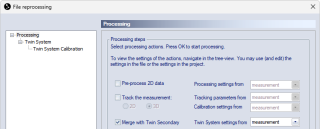Processing Twin files
The complete data from a QTM Twin system measurement is always stored in two separate files. If you have used the Merge with Twin Secondary option in the processing, the Twin secondary file automatically gets the same name as the Twin main file with the ending _secondary. When the Twin secondary file is merged with the Twin main file, it is then only the 3D data of Twin secondary system that is merged into the file. The Twin secondary system cameras are also displayed as grayed cameras in the 3D view.
The merged Twin file 3D data from the Twin secondary system is marked as Measured Secondary in the trajectory info windows, but that is the only difference compared with the other data. You can then identify and work with all of the 3D data as usual, for example apply an AIM model to all the data. However if you need to retrack the data you need to do that separately in the Twin secondary file, since the 2D data is not imported into the Twin main file.
Since only the 3D data is merged from the Twin secondary system, the following processing and input must be performed on the Twin main system.
-
Video (Qualisys video cameras or external video devices)
-
External input devices (e.g. analog boards, EMG devices or force plates)
-
Calculate 6DOF
-
Calculate force
-
Export data
Merging Twin files in reprocessing
The data of two QTM files can always be merged in reprocessing if you have not been using the Merge with Twin Secondary option or if you need to redo it because the tracking of the Twin secondary file has changed.
All of the previous Twin secondary data is deleted when you merge Twin secondary data in reprocessing.
The merging is always done by processing the Twin main file and activating the Merge with Twin Secondary option on the Processing steps list. You can edit both which Twin secondary file that is used and the Twin calibration before you reprocess the file. The Twin calibration that is used in the reprocessing is shown on the Twin system calibration page. You can change the Twin calibration by clicking the Calibrate... button, but you must make sure to click the correct Calibrate button (Manual or Using two measurements) in the Twin System calibration dialog to apply the change, for more information on the Twin calibration settings see chapter Twin System Calibration.
If you use the Reprocess  option on the Capture menu to merge the files, then you copy the Twin Secondary File location either from measurement or project. However, you can edit the file location and the Twin calibration on the Twin System page.
option on the Capture menu to merge the files, then you copy the Twin Secondary File location either from measurement or project. However, you can edit the file location and the Twin calibration on the Twin System page.
If you instead use the Batch process option on the File menu, which file is used is directly controlled by where you copy the settings from.
-
processed file
The Twin secondary file and all other Twin system settings are copied from the file that is processed and cannot be changed. -
project and present file
The processing automatically uses the file with the same name and the _secondary extension. However you can edit the Twin calibration if you need to.
Twin 3D data interpolation
It is recommended to use the same frequency in the two systems to avoid any interpolation. If you have to use a lower frequency for the Twin secondary system then it is recommended that you use a divisor of the Twin main system frequency to minimize the interpolation.
The interpolation is a linear interpolation meaning that a line is drawn between the Twin secondary 3D data. Then any time where the Twin secondary data does not exist the linear data will be used instead. The interpolated data will have a zero residual so that you can distinguish it in post processing.
